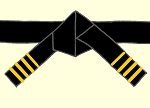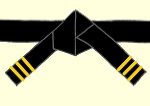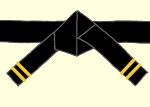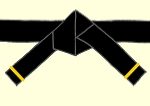Kata Information
Shi-Shi-Ban Kata
-
- Shi Shi Ban is a Goju-ryu weapons kata that was taught to Grandmaster Robert Shortlidge by Grandmaster Al Smith from Easton, PA. Shi Shi Ban is taught using the jo.
- Grandmaster Shortlidge decided that Shi Shi Ban should be taught to white belts so that they would have a weapons kata and students would be able to compete at tournaments with weapons.
- Shi Shi Ban is still taught to our white belt level students
Budo Kata
- Budo was said to have been created by Grandmaster Robert Shortlidge in 1981 in honor of his son. It was developed based on techniques with similar sized sticks taught by Al Smith from Easton, PA
- Whenever we are taught or perform this kata, we are doing so to show respect and honor his son. Budo is considered an Isshinryu kata
- Budo is no longer actively taught at our dojo
Favorite Kata
- Sensei Diven’s favorite kata is Seiunchin
- Sensei Vasquez’s favorite kata is Wansu
- Sensei Zach Miller’s favorite kata is Sunsu or Chinto
- Sensei Bennett’s favorite kata is Sanchin
Soke Tatsuo Shimabuku’s Contribution to Martial Arts
- Making of a fist – vertical, thumb on top (much “harder” fist, does not absorb the punch, more stable, less prone to injury), hit with two knuckles (concentrate power)
- Straight punch – 90 percent out and 10 percent back (cracks like a whip, less strain on the elbow), elbow in (a twist punch can be dislocated easier because the elbow is out), economy of motion, speed, can throw faster than the twist punch (can throw 2-3 punches to one twist punch), bones do not twist, when retracted ready for another punch, more power than a twist punch (mass x speed = power)
- Squat kick – “unblockable kick”
- Katas: Sunsu kata – “Son of Old Man” and was derived as a tribute to Tatsuo Shimabuku’s grandfather, an Okinawan dance master who created a dance called Sunnu-Su (shortened to Sunsu). The mayor of Kyan village gave the nickname “Sunsu” to Shimabuku because everyone knew of the dance his grandfather had created. Kusanku Sai kata
- Block protected by muscle – Changed the way we block. Use the muscles to protect the bones. He changed this after he broke his arm blocking
Four Stages of Learning
In teaching karate, Master Shimabuku stressed striking with full force when the time to strike presents itself, and relaxing completely when at peace. He believed the student must have more than a short-term commitment to benefit from karate training. Isshin-Ryu karate instructors recognize four steps in the making of a first-rate karate man. The sensei likened it to woodwork.
- Arakezuri – rough grinding and shaping – still in the process of being formed. This is the learning and practicing phase. The karateka is, at first, unrefined and with practice, moves are refined, jerky motions are removed and techniques are made better. The essential foundations of correct stance, posture, and technique are formed. This is the “physical stage”.
- Nakakezuri – middle planing. This phase is like the shaping of wood. During this stage, the student demonstrates his seriousness and willingness to work at learning the katas. Practice becomes more automatic, attention falling more on the details of execution, rhythm and the spirit of the action. At this stage, the karateka begin to generate real power in techniques and also begin to learn their application (bunkai).
- Hosokezuri – fine planing and sanding – This phase is like the sanding and the molding of the wood. The student refines his technique and may achieve the rank of BlackBelt. Kata becomes pure form, automatic, smooth, technically correct, powerful, and performed without conscious thought. This is the beginning of mental stage of kata – kata as a form of mediation.
- Shiage – being finished – This phase is like the smoothing and polishing of the wood. The student begins to understand in his own terms the Code of Karate, also called Kemp Gokui which means “Innermost Meaning.” This code, taken from Oriental literature and philosophy constitutes an attitude toward all of life and should be approached only after the student has learned all the kata and devoted the necessary time and practice to Karate Do. At this stage, kata is internalized. You are kata and kata is you. Within you is an ingrained legacy from those masters whose kata was your teacher. If you are ever threatened, you will not stand alone. The collective expertise of centuries is your guide, ever ready to spring forth and defend you.
Rules of Combat
These rules were originally contributed by Sensei John Banks.
- Avoid confrontation if at all possible. Don’t let PRIDE or EGO be your downfall.
- Never underestimate your opponent.
- Don’t let it drag on longer than necessary. The more time that passes, the more likely you are to become ENRAGED, CARELESS, and open yourself to INJURIES.
- Always be aware of your surroundings. Be ready to use objects and barriers to your ADVANTAGE.
- Don’t assume the fight is over until:
- Surrender/submission
- Knockout
- You get HELP from others
- You create an opportunity to get away.
Dan Rank Information
| Sir (Mr.) or Ma'am (Mrs./Ms.) | Sho Dan | 1st | Black Belt | |
| Ni Dan | 2nd | Black Belt (w/ 2 red stripes) | ||
| Sir, Ma'am, or Sensei | San Dan | 3rd | Black Belt (w/ 3 red stripes) | |
| Yon Dan | 4th | Black Belt (w/ 4 red stripes) | ||
| Sensei or Renshi | Go Dan | 5th | Black Belt (w/ 5 red stripes) | |
| Roku Dan | 6th | Black Belt (w/ 6 red stripes) | ||
| Master, Sensei, or Kyoshi | Nana Dan | 7th | red/white panel belt, red on ends | |
| Hachi Dan | 8th | red/white panel belt, red on ends | ||
| Sensei, Master, Grandmaster, or Hanshi | Ku Dan | 9th | Red Belt | |
| Ju Dan | 10th | Red Belt | ||
| Hanshisei - Senior leader to Model Instructors, to be modeled after | Ju Dan (normally) | 10th | 4 gold stripes |  |
| Hanshi - Senior leader to Model Instructors, to be modeled after. Exemplary Illustrious. | Ku-Dan and Ju-Dan | 9th / 10th | 3 gold stripes |  |
| Kyoshi - Master, Teaching instructor [teacher of teachers]. Eminent Instructor; Master Instructor. | Nana-Dan and Hachi-Dan | 7th / 8th | 2 gold stripes |  |
| Renshi - Senior Expert, Professional, Training instructor. Highly trained; High Attainment | Go-Dan and Roku-Dan | 5th / 6th | 1 gold stripe |  |
